The
Hall, Bradford on Avon
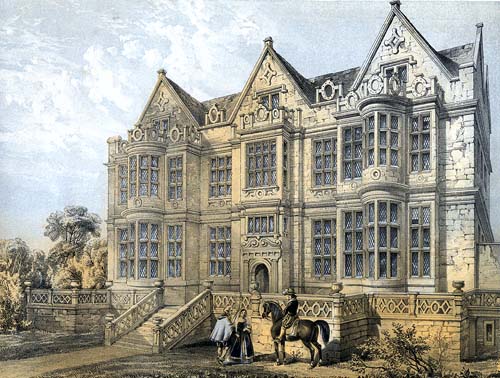
The
Hall, Bradford on Avon by C.J.Richardson 1840
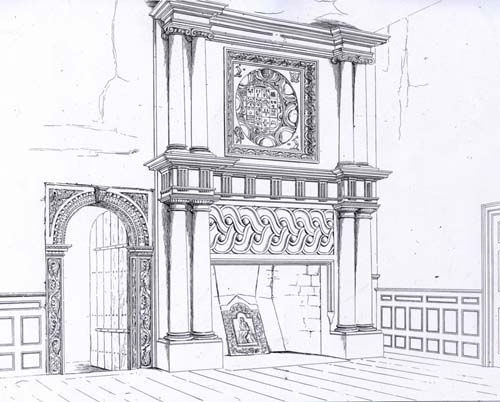
Interior of The Hall, 1850
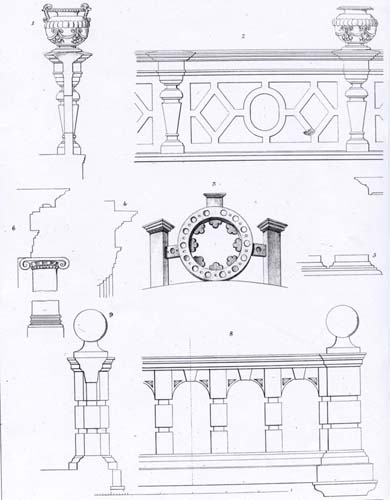
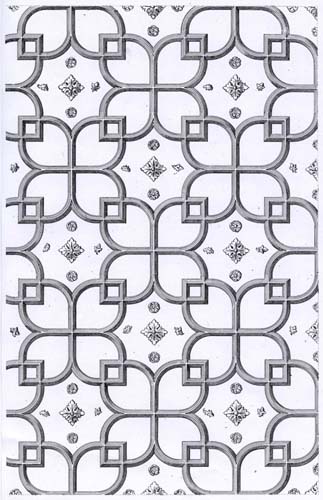
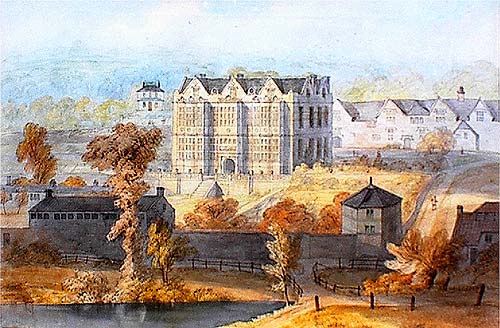
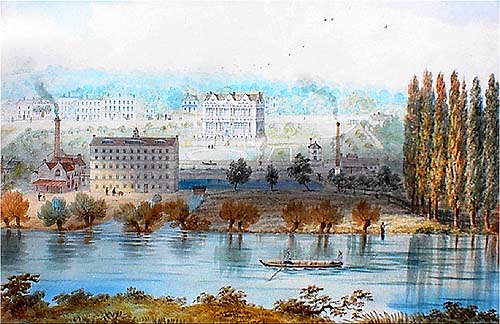
The
Kingston Mill with Hall in background by Mrs. Elizabeth Tackle 1850
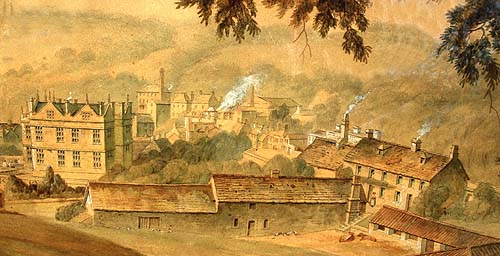
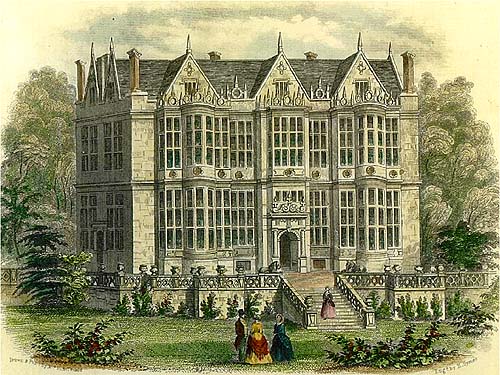
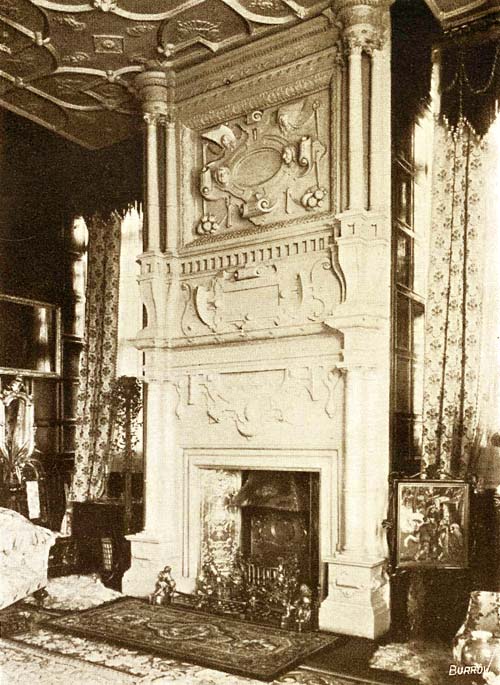
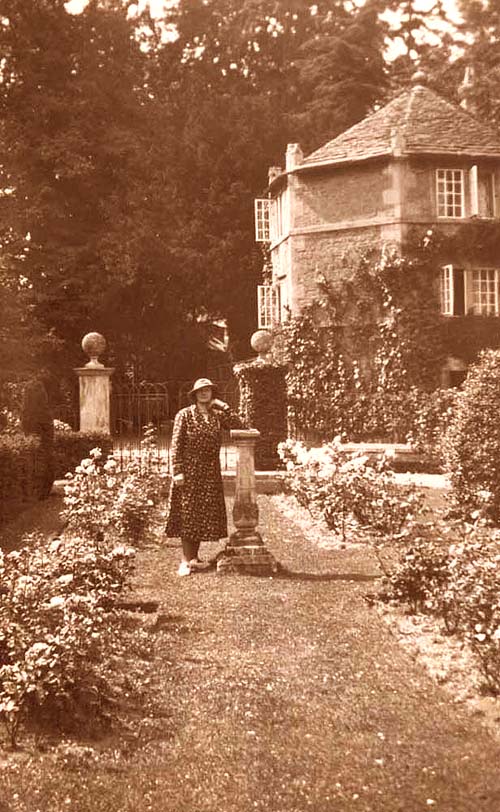
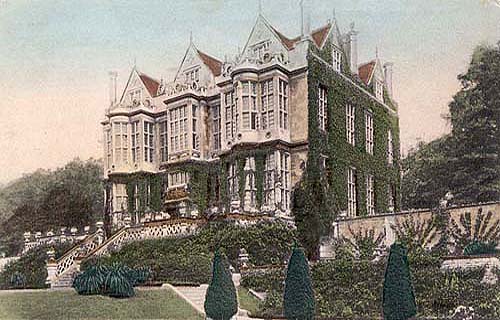
The
Hall, Bradford on Avon c.1900
An
Extract from Jones`s History of Bradford on Avon:
This is the oldest
family connected with Bradford-on-Avon of which we have anything like a detailed
account. Allusion has been already frequently made to various members of it, and,
in an early number of the Wiltshire Magazine, in a paper by Canon Jackson, on
'Kingston House,' a mansion built most probably by John Hall, the head of the
family at the end of the sixteenth or beginning of the seventeenth century, much
information is supplied on this subject. All that we need attempt, therefore,
is a brief summary of their history, adding what supplemental matter we have been
able to glean from subsequent research.
The earliest deed that has yet been
met with, relating to the "Hall" family, is one which bears date in
the reign of Henry III,Its contents imply, that, for some time previously to that
period, the family had belonged to the class of wealthy gentry.
The Herald's
Visitations carry back the pedigree only to Thomas " Halle " or "
De la Sale " who lived at the close of the fourteenth century, (But in the
Hundred Rolls, (about 1280), Eeginald de Aula and Adam de Mokesham appear as Jurors
for the Hundred of Melksham, not being given separately; and the name of Thomas
at Halle, of Bradford, appears as witnessing a deed, now at Lacock Abbey, and
dated 1320, The same name occurs in deeds dated 1357 and 1361.) More than a hundred
years, however, before that time, the Abbess of Shaftesbury, as Lady of the Manor,
had exacted her rights of wardship and marriage from the representatives of Eeginald
de Aula. ' Thomas' the first-named in the ordinary pedigrees, was the great-grandson
of ' Eeginald,' and married, about the year 1390, Alice, daughter and, by the
death of her brother Peter, sole heir of 'Thomas Atte-Forde,' (afterwards written
' Atford') from whom, no doubt, he obtained the property which is still called
Ford Farm, and which evidently furnished a surname to its previous owner. The
same Alice was also, through her mother, the ultimate heiress of Nicholas Langridge,
described as of 'Bradford.' If a conjecture may be formed from the pedigree, especially
the account given of it in one of the Harleian manuscripts,(In the Harl. MS. No.
888 we have this nc count of the earliest alliances of the Hall family.- "Thomas
Halle, of Bradford the County of Wiltes, Esquire, married Alice, sister and heir
of Peter Atford, and heirs to to Thomas at forde at Bradford, and of Edith his
wife, daughter and heire of Roger .... and Ales his wife, daughter of Nicholas
Langridge, "' Blandford, which Roger, was son to Roger .... and Joan his
wife, daughter to Thomas Lyttleton, next Bland ford, sonna And heire of Peter)
in which we have the various family connexions related narratively, it would seem
that some share of the property originally belonging to Peter Lyttleton (described
as living " nest Blandford," and whose date must be certainly before
the commencement of the thirteenth century,) must have come to Alice At-ford,
and augmented the goodly portion which she brought to the ' Hall ' family.
There
is still to be seen, carved in oak, over the chimney-piece of a panelled room
at the Hall, a shield bearing several quarterings which seem to record the various
early alliances made by members, of the Hall family. An engraving of this shield
has been given in the Wiltshire Society's Magazine (i. 268.) Amongst the quarterings
to which without difficulty a name can he assigned are those of ' Atford ' and
' Basil,' Of two, however, - the one, ' A bend between three leopard* ' (or lions')
heads erased,' the other, ' An eagle sable, preying on a fish azure,' - it is
not easy to give an accurate account. Much of very early heraldry is traditional,
and though, in books of authority, we find no such coats given to the names of
' Langridge ' or ' Littleton,' it is not impossible that these may have originally
belonged to them. This however is simple conjecture, for KB the shield contains
the cent of Besill, it may also include that of the mother of Nicholas Hall who
married Margaret Besill, of whose name and family as yet we are ignorant.
Alice
Hall survived her husband and died in the year 1426. By the failure of issue to
her eldest son Reginald, who endowed a " chaplain to serve at the altar at
St. Nicholas " in the Parish Church, the representation of the family devolved
on her second son Thomas, who was thirty years old at the time of his mother's
decease. Nicholas, the son of the last-named Thomas Hall, further increased the
wealth of the family by marrying Margaret one of the daughters and co-heiresses
of William Besill of Bradford; the other co-heiress, Cecilia, marrying Anthony
Rogers, the founder of another family in this town. Three generations pass away,
during which alliances were made with the families of Bower of Wilton,-Tropnell
of Chaldfield,-and Mervyn of Fonthill, -and we find the representative of the
family, John Hall, described as ' of Forde,' marrying, about the middle of the
sixteenth century, Dorothy only daughter and heiress of Anthony Rogers, the last
male representative of the elder branch of that family in Bradford-on-Avon, and
thus acquiring the other moiety of the Besill estate, together with her own patrimony,
part of which seems to have lain at Holt.
One of the members of this family,
to which a passing reference has just been made, Thomas Hall, who married Alice
Bower, seems to have got himself into trouble on one occasion, by something like
what is now called "contempt of Court." Summoned before the King's Justices
with reference to a debt of £100 owing to Sir John Turberville, Kt. he did
not make his appearance; the penalty of ' outlawry' soon followed. He subsequently
surrendered himself to justice, and for a time was an inmate of the Fleet prison.
Amongst the deeds and other documents found at the Hall a few years ago, during
the progress of repairs, was one, dated 18 Henry VII., which contains a "Royal
Pardon and Revocation of Outlawry for Thomas Hall, lately of Bradford, Co. Wilts,
Gentleman, now in the Meet Prison." It does not appear from the document
that the debt was paid at the time of his release from durance vile; the condition
of his liberation being that he should appear in Court "if the said John
[Turberville] should desire to speak with him touching the debt above mentioned."
Of
the others just alluded to, either 'William Hall," who married Elizabeth
Tropnell, of Chaldfield, or ' Thomas Hall,' owho married Eliza Mervyn, of Fonthill,
was probably the builder of the Chantry Chapel, of which, in our account of the
Parish Church, we have already taken notice, and which, now for many years, has
been usually termed,-"The Kingston Aisle." [Thomas executed a bond to
John Dauntsey, the date of which is interesting reading-" in the fifth and
sixth years of King Philip and Mary, by the Grace of God King and Queen of England,
the Spains, France, both Sicilies, Jerusalem and Ireland, Defenders of the Faith,
Archdukes of Austria, Dukes of Burgundy and Brabant, Counts of Hapsbury, Flaunders
and Tyrol"]
The second son of the John Hall that married Dorothy Rogers,
bore the same Christian name as his father, and succeeded, by the decease, it
is presumed, of his elder brother Thomas, at the close of the sixteenth century
to the representation of the family. He married Elizabeth, daughter of Henry Brune
of Athelhampton, Co. Dorset, and was probably the builder of the large and beautiful
mansion,-described, by Aubrey, as "the best built house for the quality of
a gentleman in Wilts,"-which, since the days of Evelyn Pierrepont, has commonly
been termed the "Duke's House" or "Kingston House,". An older
house probably stood previously on much the same site, which Leland mentions as
having seen when he visited Bradford (c. 1540) and describes as " a pratie
stone house at the este ende of the toune on the right bank of Avon." A full
account of the present house has been given in the pages of the Wiltshire Society's
Magazine (vol. i. pp. 265, &c.) and many of its details have been described
and illustrated by Mr.C. J. Richardson in his " Observations on the Architecture
of England during the reigns of Queen Elizabeth and King James I." and by
Mr. G. Vivian in a volume of " Illustrations of Claverton and the Duke's
House." Within the last few years the house, having fallen into a sadly dilapidated
condition, has been, to a great extent, rebuilt by the present proprietor, Mr.
Stephen Moulton, with so faithful an adherence to its original plan, as enables
us, whilst we acknowledge the sound judgment and correct taste of its restorer,
to appreciate fully the intentions of its first designer.1
SIR THOMAS HALL,
Knt. son of the last-named John Hall, married Catharine daughter of Sir Edward
Seymour, Bart., great-grandson of the Protector Somerset. Faithful to the cause
of his King and master, Charles I., Sir Thomas was, with many other Wiltshire
gentlemen, compelled when the Parliament triumphed to compound for his estates,
and was, in 1649, fined £660.2 (See p. 53). He lived to see the ultimate
success of the cause for which he suffered. The old Royalist died in 1663, at
the advanced age of eighty-one years.
His son,-JOHN HALL,-the last male representative
of his family, was an active magistrate in this town and neighbourhood. His name,
together with that of his brother-in-law Thomas Thynne,-called, from his presumed
wealth, "Tom of Ten Thousand,"-occurs very frequently in legal and other
documents of his period. [He was executor to that singular example of the fickleness
of fortune, arid is said by Britton to have erected the monument to him in Westminster
Abbey at his own cost and expense.} His wife was Elizabeth, second daughter of
Sir Thomas Thynne, of Longleat, the ancestor of the noble family of ' Bath.' He
seems to have added largely to his patrimony by the purchase of other estates.
From Sir Edward Hungerford, of Farleigh Castle, he bought, in 1665, the Storridge
Pastures, part of the Brooke House estate, near Westbury; and from Sir John Hanham
(who had become possessed of it in right of his wife, a daughter of Sir William
Eyre) he purchased the Manor and Advowson of Great Chaldfield. He seems to have
exercised the right of presentation to the last named living in 1678,-1689,-and
1707.
Towards the close of his life, John Hall built the Alms-houses for four
old men, of which we have spoken in an account of the ' Charities of Bradford-on-Avon.'
In front of them, cut in stone, are still to be seen the arms and crest of 1 Hall.'
Underneath the shield is the date 'A.D. 1700' and the inscription ' Deo et pauperibus.'
He
was the last of his family, and died in 1711. According to some authorities, he
left one daughter, Elizabeth, who became the wife of Thomas Baynton, Esq., of
Chaldfield. The issue of that marriage, Rachel, was the inheritor of John Hall's
large estates. Walker, in his history of Great Chaldfield, gives, on the authority
of an old manuscript, a somewhat different account, and represents ' Rachel Baynton
' as having a yet stronger claim to be the inheritor of the ' Hall' property.
The following extract is said to be taken from a MS. in the possession (in 1837)
of Mr. Waldron of Lipiat, and which was itself extracted from an °ld vellum
MS. which is now lost, but was at Monka in the year 1744. -"Sir William Eyra
of Ohaldfield ....... had two sons,
Robert and Henry. To Robert he gave Little
Chaldfield, lately sold to Mr. Baynton, who left it to his youngest son, Thomas
Baynton ; and Mr. Thomas Baynton's wife had a daughter by Mr. Hall: he gave her
all his estate; and this lady married the Marquis of Dorchester, and was mother
the last Duke of Kingston."-References confirmatory of the same fact "£8
given, in a note to Walker's Ohaldfield (p. 8.), to DUGDALE'S English Peerage
Vol. ii. p.p. 18, 19, and BURKE'S Extinct and Dormant Peerage, p. 420). A very
careful search amongst all documents, to which access could be gained, likely
to throw any light on the matter, has discovered no entry that accounts for a
daughter, Elizabeth, born to John Hall, or for the marriage of Thomas Baynton
with such daughter. Even on the presumption that John Hall died without issue
at all, Rachael, baptized at Chaldfield in April 1695 as " the daughter of
Thomas and Elizabeth Baynton," would have some claims upon him, no less than
'William Pearce,' whom, in default of her having male issue, he appointed to be
the next inheritor. 'Eachel Baynton' was in fact, through his wife, his great-niece;-'
William Pearce' was, through his sister, his great-nephew. Supposing there was
no nearer relationship, there was nothing improbable or we may add, unjust, in
John Hall's thus leaving his large estates to Rachel Baynton.
The young and
rich heiress married William Pierrepoot Esq( A special Act of Parliament was obtained
for the purpose of settling John Hall's estate* on William Pierrepont and Bachel
Baynton on their marriage. In tha Act, to the original of which, in its engrossed
form, in the Library o( the Home of Lords reference iiaa been made, tliers is
"" mention of any relationship between John Hall and Rachel Bayntan.
Tb" Act was obtained with difficulty in consequence of much opposition to
it; and matters wera the more complicated by the death of John Hall during its
progress through the Commons. A petition was presented by Williw Coward, Esq.,
who, in default of legitimate issue was Dbe nest of *'n **j John Hall, setting
forth that "the Bin, in caae it should pa"s, 'soai°-greatly prejudice
the Petitioner and praying to be heard by counsel again* it." The Bill however
passed with several amendments, and received Koyal assent 16th May, 1711. A rider
was added to the Bill to the follo"-ing "3eot:-"Provided that nothing
in this Act shall be deemed, taken, o construed, to be any allowance of, or any
-ways to approve or canfi'"* a * articles, or supposed articles of agreement
made, or pretended to be mo ^ ,1. agreed upon, by or between, the laid Lord Marquis
of Dorelmsler, _a , laid John Hall, deceased, concerning the marriage of the s">"
, Baynton with the said William Pierrepont, Esq., commonly called Kingston, &c.").
who bore the courtesy title of Lord Kingston, only son and heir of Evelyn Pierrepont,
then Marquis of Dorchester, afterwards first Duke of Kingston. A brief space only
of married happiness wai granted to her; for before she had completed her nineteenth
year she was a widow. Two children a boy and a girl, were the issue of the marriage.
Evelyn, whilst yet in early youth, succeeded his grandfather as second and last
Duke of Kingston; his mother died four years before her son came to the proud
title. His union, in later life, with 'Elizabeth Chudleigh,' better known as the
Duchess of Kingston,-(though she had no real claim to this designation), -the
strange life of this eccentric, yet gifted, woman,-her subsequent trial and conviction
for bigamy,-her closing career at St. Petersburgh,-all these have been related
by an abler pen in the pages of the Wiltshire Society's Magazine, and therefore
on these it is needless to dwell. And 'Elizabeth Chudleigh's, after all, hardly
to be reckoned among the o'Worthies' of Bradford-on-Avon. Under the will of the
last 'Duke of Kingston, however, she inherited all his personal property, and
had assured to her a life interest in all his real estate. On her death, the latter
passed to Frances, the other child of Rachel Pierrepont, who had married Philip,
eldest son of Sir Philip Meadows, Deputy Ranger of Richmond Park. Their son, Charles
Meadows, who assumed by sign-manual the surname and arms of Pierrepont, was created
Earl Manvers in 1806. On his decease in 1816, his son, who succeeded to the title
as second Earl Manvers, inherited the property, and was the representative of
the ' Halls' of Bradford-on-Avon.
Of
the time at which it was built, the style of architecture employed scarcely leaves
a doubt. It partakes of the character of Longleat; but still more strikingly resembles
a portion of Kirby, the seat of Lord Winchilsea, in Northamptonshire. The date
of Longleat House is well known. It was built between the years 1567 and 1579,
and according to a received tradition, by John of Padua, the "Devizor of
public Buildings" patronized by Henry VIII., Edward VI., and the Protector
Somerset: an architect, who is supposed by some to have been John Thorpe, an Englishman,
under the disguise of an Italian name. Kirby House was built between the years
1572 and 1638. There is therefore little difficulty in assigning Kingston House
to the commencement of the 17th century. There was at an earlier period and no
doubt upon the same site, a house belonging to the Halls of Bradford, which Leland
saw when he traveled that way in 1540. He says " Halle alias De la Sale dwellith
in a pretty stone house at the east end of the town on the right bank of Avon
: a man of £100 lands by the year: an ancient gentleman since the time of
Edward 1." The peculiar notice of a "pretty stone house" exactly
in the same situation would almost for a moment suggest the question, could the
present house by any probability be the one that Leland saw? But this is not at
all likely, as 1540 is certainly too early for the style of Kingston House.
If
Aubrey is to be trusted {which as he sometimes wrote from memory is not always
the case) the house as it now appears, is only the central portion of the original
building. For according to his description of it in 1670 it had, when complete,
two wings. In his chapter upon "Echos" he says: "After the Echoes
I would have the draught of the house of John Hall of Bradford, Esq., which is
the best built, house for the quality of a gentleman in Wilts. It was of the best
architecture that was commonly used in King James the First's reigns. It is built
all of freestone, full of windows, hath two wings : the top of the house adorned
with rails and baristers. There are two if not three elevations or ascents to
it: the uppermost is adorned with terraces, on which are rails and baristers of
freestone. It faceth the river Avon, which lies south of it, about two furlongs
distant on the north side is a high hill. Now, a priori, I doe conclude, that
if one were on the south side of the river opposite to this elegant house, there
must of necessity be a good echo returned from the house; and probably if one
stand east or west from the house at a due distance, the wings will afford a double
echo."
"Whether wings would have been any improvement to the house
is a question of taste: but whether there really ever were any is a matter of
considerable doubt. Aubrey's description is evidently from recollection; for if
it had been made on the spot he could not have expressed himself, as he does,
with uncertainty as to the number of terraces. Neither does the echo experiment
appear to have been one that he had actually tried, but merely one that probably
would have produced a particular effect, if tried. A recent examination of the
masonry and general structure leads us to the conclusion that Aubrey must have
been mistaken. There is not the slightest appearance against the sides of the
house of its ever having had any appendages of the kind. The facade on the western
side (as seen in the print) is perfectly regular, is built of ashlar and has a
large doorway in the centre. On the eastern side indeed the masonry is rough and
the elevation irregular; but still there is no trace of any projection. The mistake
may perhaps be accounted for in this way. There was formerly a range of offices
and stables behind and longer than the house. This seen from a distance may have
presented the appearance of wings.
"The principal front to the south was
divided into two stories with attics in the gable, and was occupied by large windows
with stone mullions. These were formed by three projections, the central one coming
forward square, since the two side ones with semicircular bows. In the centre
was a large sculptured doorway to a porch, and the summit of the window bays was
adorned with open parapets.
"The " Duke's House " is noticed
in a work called " Observations on the Architecture of England, during the
reigns of Queen Elizabeth and King James I," by Mr. C. J. Richardson, who
has introduced four illustrations of it. 1. The external view. 2. A fireplace
and stone mantelpiece in the entrance hall. 3, A mantelpiece of oak on the upstairs
floor; and 4. A ceiling. The same plates, with two others of details, appear also
in a volume of "Illustrations of Claverton and the Duke's House," published
by George Vivian, Esq., of the former place.
In these works it is described
as being of the transition style between the old Tudor or perpendicular, and the
new or Palladian. Many of the enrichments peculiar to it are of German invention;
arti-:'a of that nation having been then much in vogue. The excess of window light,
characteristic of houses of that style, and ao lernarkable in the instance before
us, gave occasion to Lotd Bacon's observation, that "such bouses are sometimes
so full of glass that one cannot tell where to become, to be out of the way of
the sun or the oold."
One of the terraces with open balustrades of stone,
the orchard and the garden, are all that remain out of doors. The offices, gate-houses
and every other appendage that it may have had of suitable character, as fountains
and bowling green, &a., have disappeared.
A Complaint being made of a Breach of Privilege, committed upon Mr. Hall, a Member of this House, by Robert Beach, an Attorney of Woolley in the Parish of Bradford in the County of Wiltshire, and Simon Deverell, a Bailiff of Bradford aforesaid; in assaulting and wounding the said Mr. Hall, and his Servant; and threatening to do him further Mischief; during the Sitting and Privilege of Parliament;
Ordered, That the said Robert Beach and Simon Deverell be sent for in Custody of the Serjeant at Arms attending this House, to answer their Breach of Privilege, committed against Mr. Hall, a Member of this House; in assaulting and wounding the said Mr. Hall, and his Servant; and threatening to do him further Mischief; during the Sitting and Privilege of this House. From: 'House of Commons Journal Volume 9: 31 January 1678', Journal of the House of Commons: volume 9: 1667-1687 (1802), pp. 429-30.
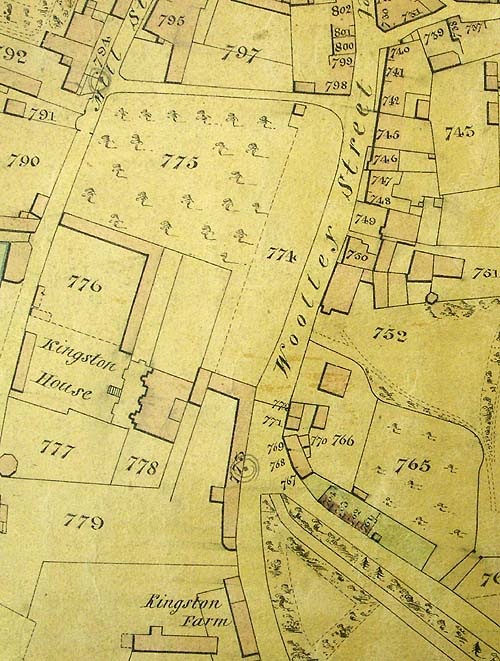
1837
Map of Town